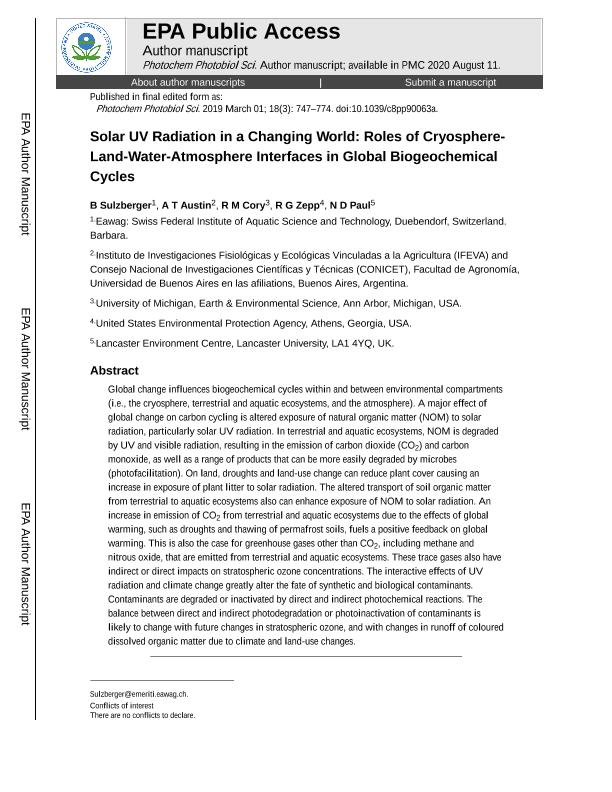Mostrar el registro sencillo del ítem
dc.contributor.author
Sulzberger, B.
dc.contributor.author
Austin, Amy Theresa

dc.contributor.author
Cory, R. M.
dc.contributor.author
Zepp, R. G.
dc.contributor.author
Paul, N. D.
dc.date.available
2022-02-04T19:13:43Z
dc.date.issued
2019-01
dc.identifier.citation
Sulzberger, B.; Austin, Amy Theresa; Cory, R. M.; Zepp, R. G.; Paul, N. D.; Solar UV radiation in a changing world: roles of cryosphere-land-water-atmosphere interfaces in global biogeochemical cycles; Royal Society of Chemistry; Photochemical and Photobiological Sciences; 18; 3; 1-2019; 747-774
dc.identifier.issn
1474-905X
dc.identifier.uri
http://hdl.handle.net/11336/151388
dc.description.abstract
Global change influences biogeochemical cycles within and between environmental compartments (i.e., the cryosphere, terrestrial and aquatic ecosystems, and the atmosphere). A major effect of global change on carbon cycling is altered exposure of natural organic matter (NOM) to solar radiation, particularly solar UV radiation. In terrestrial and aquatic ecosystems, NOM is degraded by UV and visible radiation, resulting in the emission of carbon dioxide (CO2) and carbon monoxide, as well as a range of products that can be more easily degraded by microbes (photofacilitation). On land, droughts and land-use change can reduce plant cover causing an increase in exposure of plant litter to solar radiation. The altered transport of soil organic matter from terrestrial to aquatic ecosystems also can enhance exposure of NOM to solar radiation. An increase in emission of CO2 from terrestrial and aquatic ecosystems due to the effects of global warming, such as droughts and thawing of permafrost soils, fuels a positive feedback on global warming. This is also the case for greenhouse gases other than CO2, including methane and nitrous oxide, that are emitted from terrestrial and aquatic ecosystems. These trace gases also have indirect or direct impacts on stratospheric ozone concentrations. The interactive effects of UV radiation and climate change greatly alter the fate of synthetic and biological contaminants. Contaminants are degraded or inactivated by direct and indirect photochemical reactions. The balance between direct and indirect photodegradation or photoinactivation of contaminants is likely to change with future changes in stratospheric ozone, and with changes in runoff of coloured dissolved organic matter due to climate and land-use changes.
dc.format
application/pdf
dc.language.iso
eng
dc.publisher
Royal Society of Chemistry

dc.rights
info:eu-repo/semantics/openAccess
dc.rights.uri
https://creativecommons.org/licenses/by-nc-sa/2.5/ar/
dc.subject
UV RADIATION
dc.subject
BIOGEOCHEMICAL CYCLES
dc.subject
SOLAR RADIATION
dc.subject
CLIMATE CHANGE
dc.subject.classification
Otras Ciencias de la Tierra y relacionadas con el Medio Ambiente

dc.subject.classification
Ciencias de la Tierra y relacionadas con el Medio Ambiente

dc.subject.classification
CIENCIAS NATURALES Y EXACTAS

dc.title
Solar UV radiation in a changing world: roles of cryosphere-land-water-atmosphere interfaces in global biogeochemical cycles
dc.type
info:eu-repo/semantics/article
dc.type
info:ar-repo/semantics/artículo
dc.type
info:eu-repo/semantics/publishedVersion
dc.date.updated
2020-12-15T14:18:51Z
dc.journal.volume
18
dc.journal.number
3
dc.journal.pagination
747-774
dc.journal.pais
Reino Unido

dc.journal.ciudad
Cambridge
dc.description.fil
Fil: Sulzberger, B.. Swiss Federal Institute of Aquatic Science and Technology; Suiza
dc.description.fil
Fil: Austin, Amy Theresa. Consejo Nacional de Investigaciones Científicas y Técnicas. Oficina de Coordinación Administrativa Parque Centenario. Instituto de Investigaciones Fisiológicas y Ecológicas Vinculadas a la Agricultura. Universidad de Buenos Aires. Facultad de Agronomía. Instituto de Investigaciones Fisiológicas y Ecológicas Vinculadas a la Agricultura; Argentina
dc.description.fil
Fil: Cory, R. M.. University of Michigan; Estados Unidos
dc.description.fil
Fil: Zepp, R. G.. United States Environmental Protection Agency; Estados Unidos
dc.description.fil
Fil: Paul, N. D.. Lancaster University; Reino Unido
dc.journal.title
Photochemical and Photobiological Sciences

dc.relation.alternativeid
info:eu-repo/semantics/altIdentifier/doi/http://dx.doi.org/10.1039/C8PP90063A
dc.relation.alternativeid
info:eu-repo/semantics/altIdentifier/url/https://pubs.rsc.org/en/content/articlelanding/2019/PP/C8PP90063A
Archivos asociados
